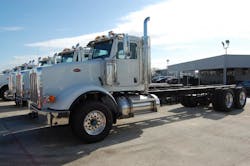The latest Trucking Conditions Index (TCI) metric compiled by FTR Transportation Intelligence offers a good case in point.
In March, FTR said its TCI metric jumped more than one point to a reading of 8.69, reflecting extremely tight capacity in the truckload sector. That being said, though, Jonathan Starks, FTR’s director of transportation analysis, cautioned that there remains a possibility for some relief of the tight truckload capacity over the next few months if freight growth slows as expected in the second quarter.
He added that the stressed capacity situation of today is caused, primarily, by regulatory drag on shipping capacity along with the winter disruptions. However, even with those caveats in mind, FTR believes its TCI indicator for the remainder of 2014 is expected to remain at the same level, meaning trucking capacity will stay tight.
“Truckers should be feeling much better now that they have finally been able to use the ever tightening truck supply to get much needed rate gains,” Starks said. “It looks like much of the supply-and-demand balance is coming back down to a more ‘normal’ level as shippers are finishing their spring freight season and the backlog of loads caused by the winter weather has largely subsided.”
He stressed however that “normal” remains a relative term since the industry continues to be operating at much higher levels of utilization than what’s been seen in the past. “Recent data shows a strong uptick in economic activity, but it will be hard to know if we are merely playing catch-up from a bad first quarter or if there is some real sustained growth occurring.”Mark Montague, a pricing analyst with DAT Solutions, echoed that same question regarding the “normalcy” of the current freight market is a recent blog post, though he also pointed out that it’s been a “year of record freight” on the spot market so far, despite the rough winter weather.
In March, for example, freight availability rose 56% on the DAT North American Index, including Canada, compared to the same month in 2013. Within the U.S. the year-over-year change was even more dramatic: a 64% increase divided among the dry van (63%), flatbed (58%) and refrigerated (70%) trailer segments of the truckload business.
So how’s all of this freight activity – or sometimes the dearth of it – affecting truck sales? From FTR’s perspective, preliminary data for April indicated North American Class 8 truck net orders at 24,115, which is 11% below March results yet still 5% above a year ago.
Overall, FTR’s data indicates that when Class 8 orders over the last six months are annualized, the market is hovering around 334,000 units, which is pretty strong.
“April orders generally met our expectations and are in line with our forecast,” noted Don Ake, FTR’s VP of commercial vehicles. “Class 8 order activity was bound to fall back some from the velocity of the past four months. With orders up almost 28% year to date, the industry is on track for a great year.”Kenny Vieth, president and senior analyst with ACT Research, also sees a similar “strengthening” pattern in the truck order data he examines.
He said total North America orders of Class 5 through 8 trucks totaled 42,200 units in April, and while that ranks as only the sixth best order month in the past seven, April is also the 10th best order month of the past eight years.
Since truck demand began increasing during the fourth quarter last year, Vieth said total Class 5-8 net orders indicated a 545,300 unit annual rate from here he sits.
[However, he also stressed earlier this year at the Mid America Trucking Show that improving utilization is lowering demand for new equipment to a degree. Click here to read more about that.]
Vieth’s data also indicates that April North American Class 5-7 net orders are expected total 17,800 units (plus or minus 5%), with Class 8 net orders topping out at 24,400 units (again plus or minus 5%) when actual numbers get released last in May.
“Class 5-7 saw strong orders continue through April,” Vieth added. “For April, net orders rose 5% from April 2013 but fell to 2% from February to 17,800 units. Consistency continues to be a part of the medium-duty vehicle order story: Over the past three, six, and 12 months, orders have been booked at a seasonally adjusted annualized rate (SAAR) of 219,000, 209,000, and 209,000, respectively.”Truck makers themselves remain bullish to a degree on truck sales volumes. Take Paccar Inc. for example – parent company to Peterbilt Motors Co. and Kenworth Truck Co. – which posted net income of $273.9 million on consolidated net sales and revenues of $4.38 billion in the first quarter this year.
Dan Sobic, Paccar’s executive VP, noted that his company believes Class 8 industry retail sales for the U.S. and Canada in 2014 are expected to be in a range of 220,000 to 40,000 vehicles, compared to the 212,000 vehicles sold in 2013.
“The increased market is due primarily to the ongoing replacement of the aging truck population and improving construction and automotive sectors," he said. "The truck market in 2014 may also benefit from some expansion of industry fleet capacity, reflecting continued strong freight demand.”
On a side note to that, Paccar said its parts division is generating big bucks, with revenues hitting $726.6 million in the first quarter of 2014, a 9% increase compared to the first quarter of 2013.
"The growth in Paccar's aftermarket part sales has been driven by ongoing investment in distribution, technology and products, including the growth of Paccar global TRP all-makes brand," noted David Danforth, Paccar Parts general manager. "Improving fleet utilization and the age of the North American truck fleet are contributing to excellent parts and service business.”
Certainly a lot of things to chew over as the weather becomes ever warmer and freight flows hopefully keep on increasing.







